Eggs of Terrestrial Salamanders Found in Calfornia

| I don't have pictures of all of the eggs of amphibians native to California, but I will show those I do have here, in hope that it might make them easier to identify and compare with the eggs of other sympatric amphibians. If you have pictures of eggs not shown here that you can positively identify and would like to contribute, please let me know, they will be very much appreciated. For pictures and information about the salamanders, click on the name links. |
||
| These are eggs laid by salamanders on land. Other salamanders lay eggs in water. You can see these on the Aquatic Salamander Eggs page. I have very few pictures of the eggs of terrestrial salamanders. Often little is known about the breeding behavior of terrestrial salamander species. It is presumed that the females lay their eggs on land underneath rocks or logs or inside logs where they are not easily discovered. Eggs are usually laid individually and are not surrounded with as much jelly as eggs that are laid in water. Most female salamanders remain with their eggs to protect them from predators. Young hatch from the eggs as miniature versions of adults. |
||
| Speckled Black Salamander - Aneides flavipunctatus flavipunctatus Santa Cruz Black Salamander - Aneides flavipunctatus niger |
||
Females probably lay from 8 - 25 eggs in moist cavities belowthe ground in July and August. Eggs are attached by peduncles. Females stay with the eggs until they hatch. |
||
| Clouded Salamander - Aneides ferreus | ||
In late June and July, females lay a clutch of 9 - 17 eggs in moist places on land, including decomposing logs, and possbly in the forest canopy (where brood sites of A. vagrans have been found.) Eggs have been found with a female attending them, with a male and female attending them, and with no adults in attendance. |
||
| Arboreal Salamander - Aneides lugubris | ||
In late spring and early summer, females lay from 5 - 24 eggs in moist places, most commonly in decaying cavities of live oak trees, sometimes high off the ground, and also under rocks and other surface objects and inside logs, then remain with them, often coiled around them, until they hatch. Sometimes the eggs of several salamanders are found together in large masses. |
||
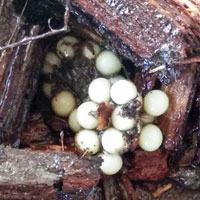 |
||
| These eggs were found in late July in Sonoma County, along with several aestivating Arboreal Salamanders. | ||
| Wandering Salamander - Aneides vagrans | ||
Females lay from 6 - 9 eggs in moist places on land in spring and early summer. Eggs have been found under the bark of a rotting Douglas fir log and at the base of a tree limb high up a tree. Females probably stay with the eggs until they hatch. |
||
| Below is a series of pictures all © Spencer Riffle showing a female Wandering Salamander in Humboldt County brooding her eggs over a period of just over three months, when the eggs hatch and we can see the tiny hatchlings. Click Here to see a larger view. |
||
 |
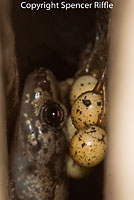 |
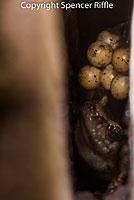 |
| Female with eggs - 7/9 | Female with eggs - 7/10 | Female with eggs - 7/16 |
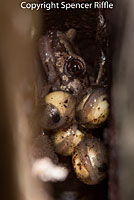 |
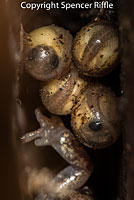 |
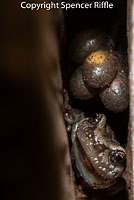 |
| Female with eggs - 9/2 | Female with eggs - 9/2 | Female with eggs - 9/25 |
| Eggs of Slender Salamanders, Genus Batrachoseps | ||
Eggs are laid individually in groups and hidden inside or underneath surface objects where there is moisture. They eggs below are probably similar to the eggs of all of the slender salamanders found in California. |
||
| California Slender Salamander - Batrachoseps attenuatus | ||
Eggs are laid in October and November, shortly after the beginning of the fall rains. Clutch sizes of 4 - 13 eggs have been recorded. Females deposit eggs in moist areas under objects such as rocks and logs or underground. Several females may lay eggs in the same location creating a communal nest, but they apparently do not remain with the eggs. However, adult salamanders have been found at egg deposition sites. |
||
| Gregarius Slender Salamander - Batrachoseps gregarius | ||
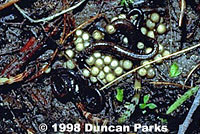 |
||
| These Gregarius Slender salamanders were found underneath ground debris along with some Gregarius Slender salamander eggs. As their name indicates, this species often forms communal nests, but the females typically leave the site after laying. Male and sub-adult salamanders will often still be found under the same cover as the eggs, which is probably what is seen here. © 1998 Duncan Parks |
||
| Ensatina Eggs - Ensatina eschscholtzii | ||
Below you can see both the eggs and the hatchlings as well as two females who are brooding their eggs. The eggs of the two subspecies seen below should look the same as the eggs of every Ensatina subspecies. |
||
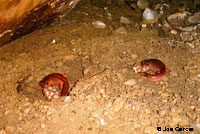 |
 |
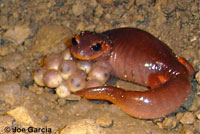 |
| On August 3rd, Joe Garcia found these intergrade Monterey Ensatinas attending their eggs under a board underneath a house in Monterey County. Female Ensatinas stay with their eggs to protect them until they hatch. © Joe Garcia |
||
 |
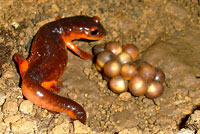 |
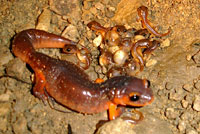 |
| On September 19th, Joe returned to the crawl space, looked under the board, and found that most of the eggs of one female had just hatched, with at least 10 hatchlings still next to the eggs. © Joe Garcia |
||
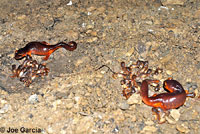 |
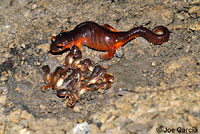 |
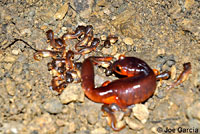 |
| Two days later, all of the eggs of both females had hatched and the juveniles were still with the females. © Joe Garcia | ||
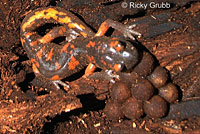 |
||
| On August 2nd in Tulare County, Ricky Grubb photographed this adult Sierra Nevada Ensatina brooding approximately 10 eggs inside a rotting log of a fallen Giant Sequoia. © Ricky Grubb | ||
| Limestone Salamander - Hydromantes brunus | ||
Females lay eggs most likely in deep moist talus or crevices in late spring. |
||
| Mount Lyell Salamander - Hydromantes platycephalus | ||
Little is known about the breeding behavior of this species. Females presumably lay eggs in early summer. |
||
| Shasta Salamander - Hydromantes shastae | ||
Females apparently lay eggs in moist limestone shelters in late summer and brood them until they hatch in late fall. Two clutches of 9 eggs were found in a cave by Gorman in 1956. |
||
| Scott Bar Salamander - Plethodon asupak Siskiyou Mountains Salamander - Plethodon stormi |
||
Little is known about the breeding habits of these species. If breeding is similar to that of the related species P. stormi, mating probably occurs in the spring, with females laying eggs in underground nests in spring or early summer and brooding them until fall. |
||
| Dunn's Salamander - Plethodon dunni | ||
Females presumably lay and brood eggs underground in rocky habitats during spring and early summer, but this is not certain. One egg mass consisting of nine eggs in a grape-like cluster was found in Oregon on July 6th, 1952. |
||
| Del Norte Salamander - Plethodon elongatus | ||
Females lay eggs most likely in underground nests, probably under rocky talus, in spring or early summer and it is presumed that they brood them until they hatch in the fall. Eggs have been found at the base of a redwood fence post. There were 10 eggs in a grape-like cluster. |
||
Return to the Top
© 2000 -
